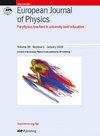(Avoided) crossings in the spectra of matrices with globally degenerate eigenvalues
IF 0.8
4区 教育学
Q4 EDUCATION, SCIENTIFIC DISCIPLINES
引用次数: 0
Abstract
Abstract (Avoided) crossings are ubiquitous in physics and are connected to many physical phenomena such as hidden symmetries, the Berry phase, entanglement, Landau–Zener processes, the onset of chaos, etc. A pedagogical approach to cataloging (avoided) crossings has been proposed in the past, using matrices whose eigenvalues avoid or cross as a function of some parameter. The approach relies on the mathematical tool of the discriminant, which can be calculated from the characteristic polynomial of the matrix, and whose roots as a function of the parameter being varied yield the locations as well as degeneracies of the (avoided) crossings. In this article we consider matrices whose symmetries force two or more eigenvalues to be degenerate across the entire range of variation of the parameter of interest, thus leading to an identically vanishing discriminant. To show how this case can be handled systematically, we introduce a perturbation to the matrix and calculate the roots of the discriminant in the limit as the perturbation vanishes. We show that this approach correctly generates a nonzero ‘reduced’ discriminant that yields the locations and degeneracies of the (avoided) crossings. We illustrate our technique using the matrix Hamiltonian for benzene in Hückel theory, which has recently been discussed in the context of (avoided) crossings in its spectrum.(避免)具有全局退化特征值的矩阵谱中的交叉
(避免)交叉在物理学中无处不在,并且与许多物理现象有关,如隐藏对称性、Berry相位、纠缠、朗道-齐纳过程、混沌的开始等。过去已经提出了一种编目(避免)交叉的教学方法,使用特征值避免或交叉的矩阵作为某些参数的函数。该方法依赖于判别式的数学工具,它可以从矩阵的特征多项式中计算出来,其根作为参数变化的函数产生(避免的)交叉的位置和简并度。在本文中,我们考虑其对称性迫使两个或多个特征值在整个参数变化范围内退化的矩阵,从而导致相同消失的判明式。为了说明如何系统地处理这种情况,我们在矩阵中引入一个扰动,并在扰动消失时计算极限中判别式的根。我们证明了这种方法正确地产生了一个非零的“简化”判别式,它产生了(避免的)交叉点的位置和简并度。我们使用h ckel理论中苯的矩阵哈密顿量来说明我们的技术,该理论最近在其光谱(避免)交叉的背景下进行了讨论。
本文章由计算机程序翻译,如有差异,请以英文原文为准。
求助全文
约1分钟内获得全文
求助全文
来源期刊

European Journal of Physics
物理-物理:综合
CiteScore
1.70
自引率
28.60%
发文量
128
审稿时长
3-8 weeks
期刊介绍:
European Journal of Physics is a journal of the European Physical Society and its primary mission is to assist in maintaining and improving the standard of taught physics in universities and other institutes of higher education.
Authors submitting articles must indicate the usefulness of their material to physics education and make clear the level of readership (undergraduate or graduate) for which the article is intended. Submissions that omit this information or which, in the publisher''s opinion, do not contribute to the above mission will not be considered for publication.
To this end, we welcome articles that provide original insights and aim to enhance learning in one or more areas of physics. They should normally include at least one of the following:
Explanations of how contemporary research can inform the understanding of physics at university level: for example, a survey of a research field at a level accessible to students, explaining how it illustrates some general principles.
Original insights into the derivation of results. These should be of some general interest, consisting of more than corrections to textbooks.
Descriptions of novel laboratory exercises illustrating new techniques of general interest. Those based on relatively inexpensive equipment are especially welcome.
Articles of a scholarly or reflective nature that are aimed to be of interest to, and at a level appropriate for, physics students or recent graduates.
Descriptions of successful and original student projects, experimental, theoretical or computational.
Discussions of the history, philosophy and epistemology of physics, at a level accessible to physics students and teachers.
Reports of new developments in physics curricula and the techniques for teaching physics.
Physics Education Research reports: articles that provide original experimental and/or theoretical research contributions that directly relate to the teaching and learning of university-level physics.
 求助内容:
求助内容: 应助结果提醒方式:
应助结果提醒方式:


